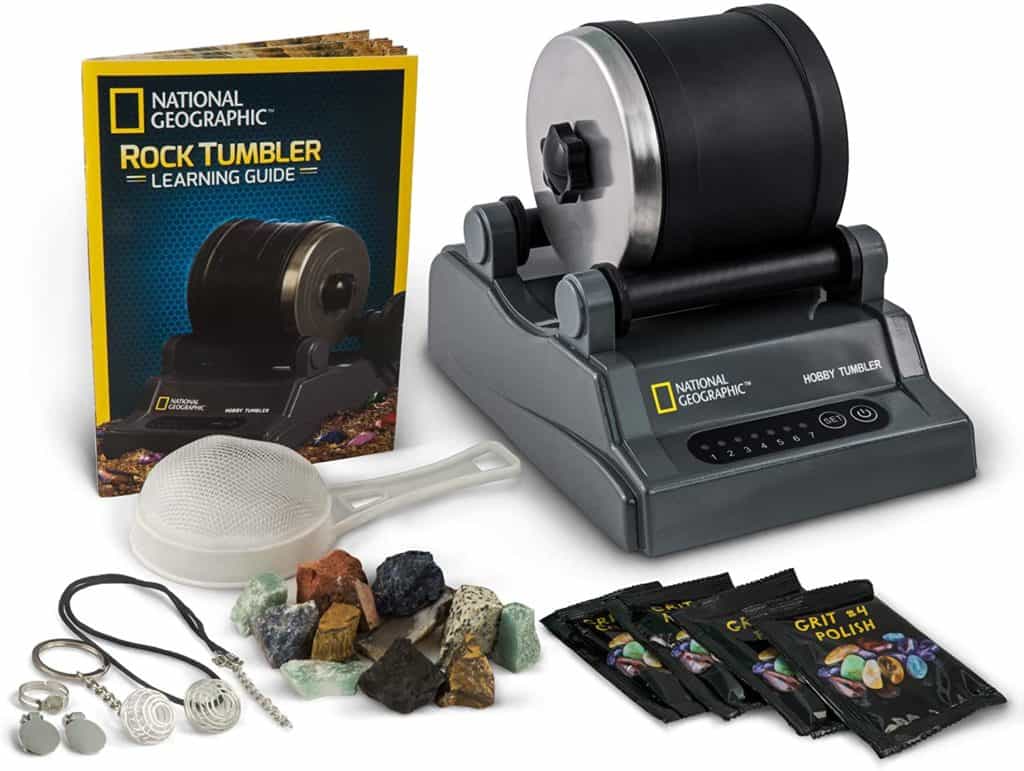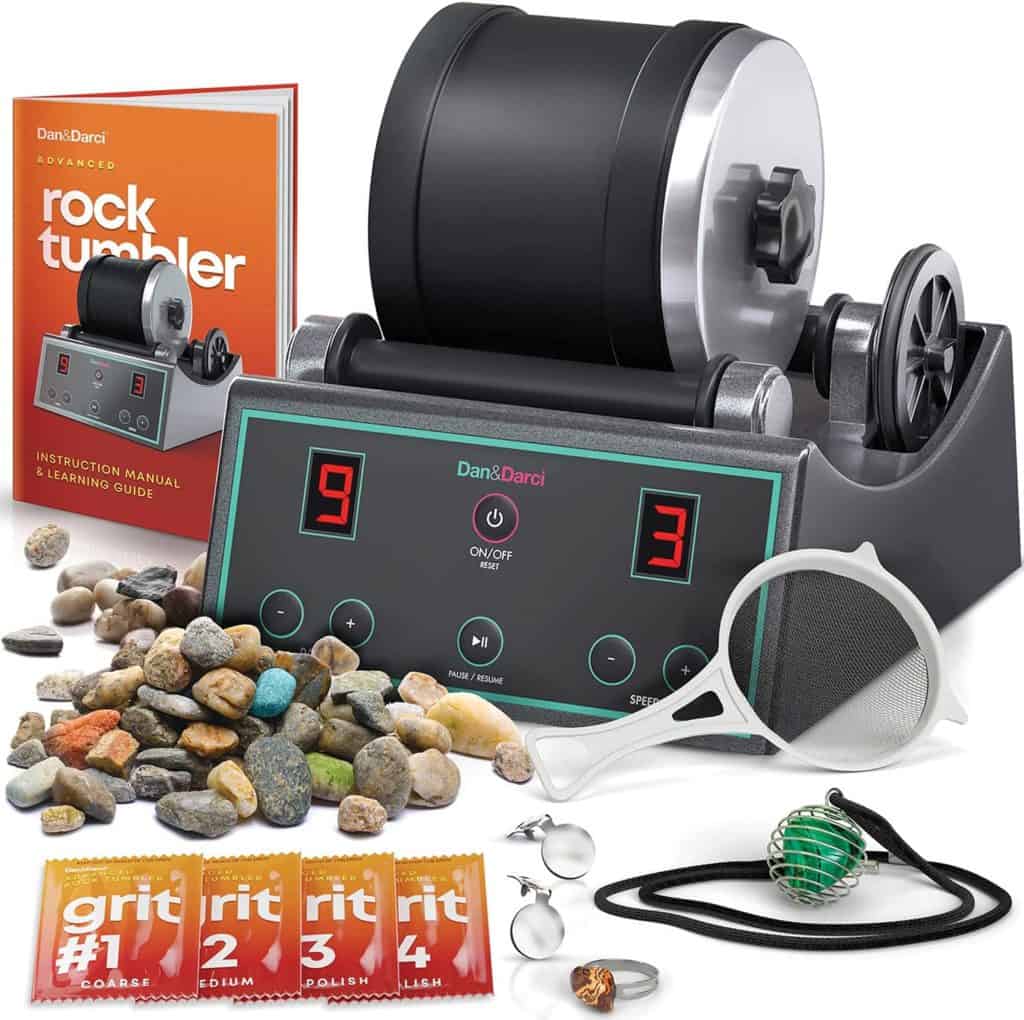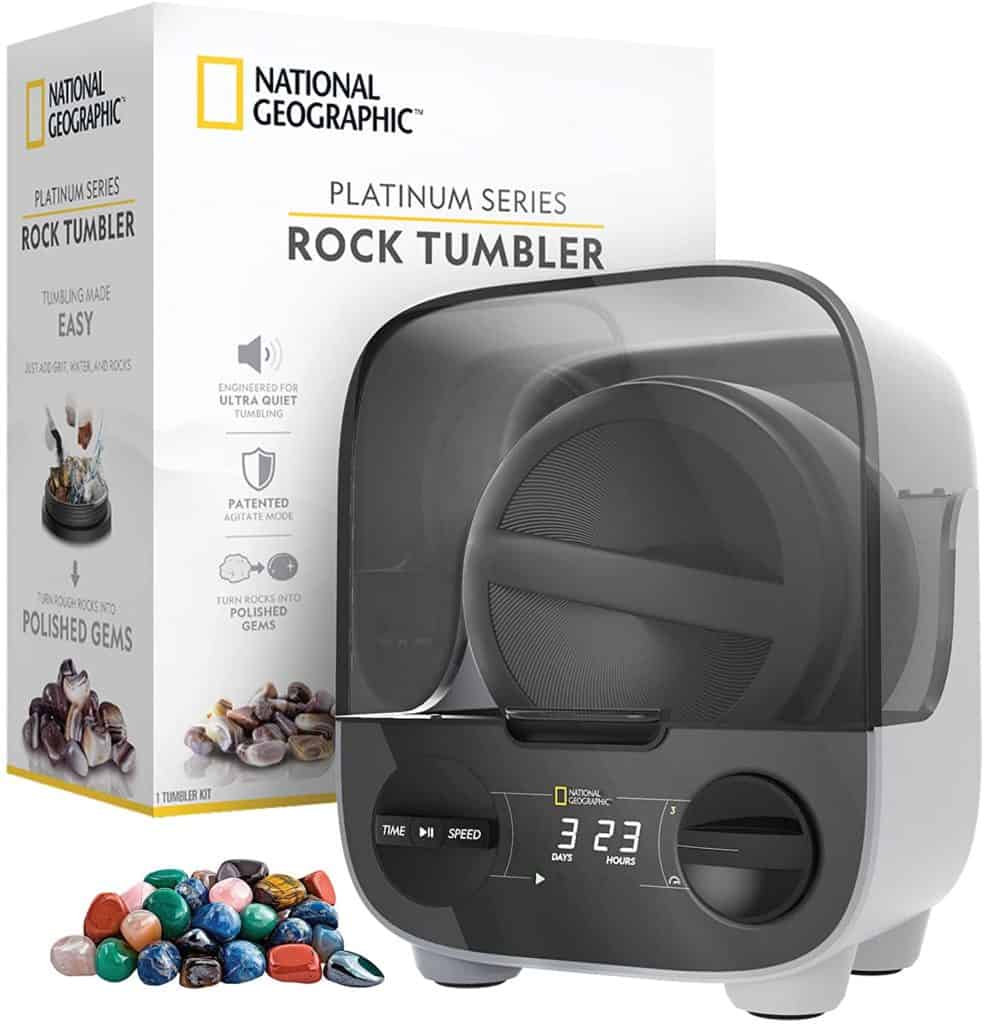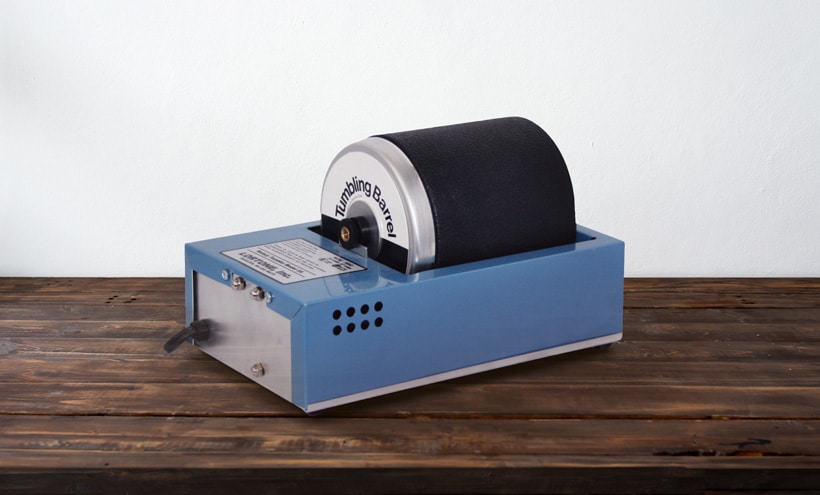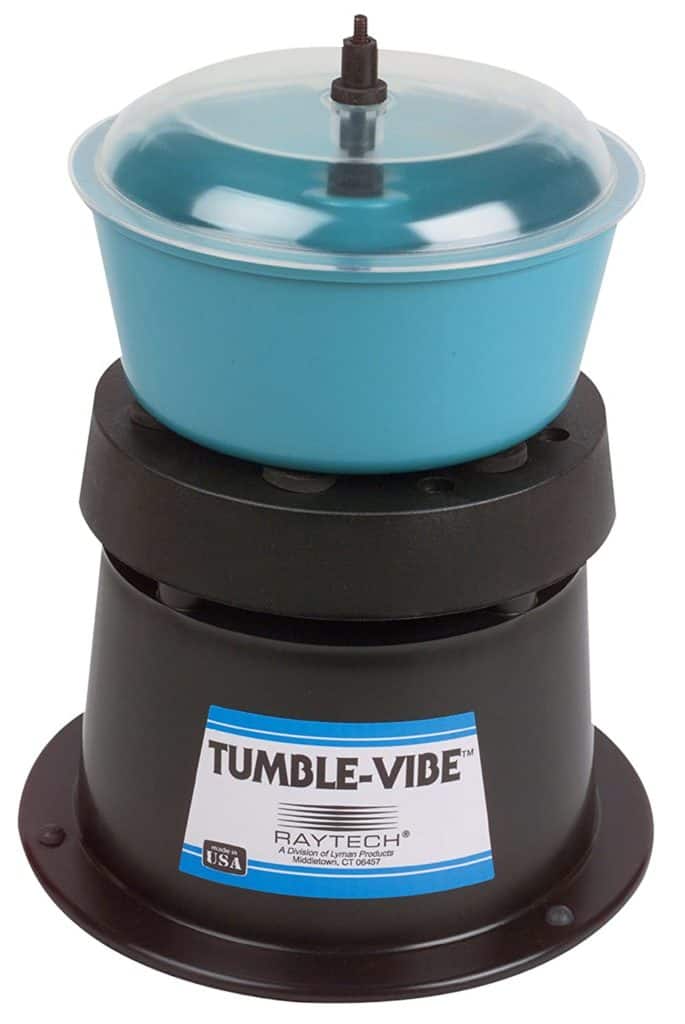Choosing the best rock tumbler is easy when you know what to look for. Here are my top picks for each category of tumblers:
Here are the best rock tumblers
- National Geographic Hobby Tumbler: best rock tumbler for kids
- Dan & Darci Advanced Tumbler Kit: best starter kit for hobbyists
- National Geographic Professional Tumbler: best option for slightly more advanced users
- Lortone 3A: best professional-grade tumbler for hobbyists
- Raytech Tumble-Vibe: best vibratory polisher (not a traditional tumbler)
Rock tumbling is a fun hobby that can be enjoyed by people of all ages. This article will break it all down and help you choose a tumbler that best suits your individual needs.
Best kids rock tumbler
National Geographic Hobby Tumbler
What we like:
- Affordable price
- Simplicity
- Kid-friendly
- Fun for all ages
What we don’t like:
- Not the same build quality compared to more expensive tumblers
Best rock tumbling kit
Dan & Darci Advanced Tumbler Ki
What we like:
- Comes with everything you need to get started
- Easy to use
- Professional-grade
- Will never leak
- Hard rubber barrel for reduced noise levels
What we don’t like:
- Can get hot to the touch if not filled correctly
Advanced hobbyists
National Geographic Professional Tumbler
What we like:
- Larger, 4 lb barrel
- Hard rubber barrel for reduced noise levels
- Professional-grade
What we don’t like:
- Does not come with grit or stones
Best professional-grade rock tumbler
Lortone 3A
What we like:
- Easy to use
- Professional-grade
- Will never leak
- Hard rubber barrel for reduced noise levels
What we don’t like:
- Does not come with grit or stones
- Can get hot to the touch if not filled correctly
Best vibratory tumbler
Raytech Tumble-Vibe
What we like:
- Removable heavy polyethylene bowl
- Cyclonic effect moves objects throughout bowl
- Small, compact, well-made
What we don’t like:
- Not used for tumbling (only polish)
Buying guide
This article is broken into a few sections based on intended use of the tumbler. We’ll also talk about some of the things to look for when choosing the best tumbler to buy.
In this guide:
What to look for when buying a rock tumbler
The first thing to consider is what will be the intended use of the tumbler you want to buy?
Are you buying this for a child?
Are you buying this for yourself because you want to start making jewelry?
Let’s take a look at some of the things you should look for when choosing a tumbler. For this article, I will not be talking much about kids tumblers. I have a separate article on this topic which you can find here.
Here are some things you should look for and consider when deciding which is the best rock tumbler for you:
Barrel size
One of the biggest decisions you’ll have to make when choosing a tumbler is what size barrel to get.
When shopping for a tumbler, you’ll notice that sizing is expressed in weight – the most common size for beginners and hobbyists being 3 lb.
Put simply; a 3 lb barrel means that for each load, you should use 2 lbs of rocks with the other pound being made up of grit and water.
For beginners and those who just want to tumble as a fun pastime, you’ll most likely want a 3-4 lb tumbler.
For folks who are more serious about the hobby and want to be able to tumble more rocks, a 6 lb or 12 lb tumbler would be your best bet.
For commercial use, you’ll want to look at the larger 20 lb and 40 lb heavy-duty machines.
If you’re new to the hobby, it might seem like bigger is better.
Well, that’s not necessarily true.
The size you choose depends on two things really: how many rocks you want to tumble at a time, and what size rocks you want to tumble.
Rock tumblers have to be filled with a certain amount of grit which is dictated by the size of the barrel, and how many rocks you’re tumbling.
So if your barrel is too large, you might end up having to make up the difference with grit and other forms of media.
You should always try to fill your barrel about 65-75% of the way with your rocks. So if you buy too large, you’ll have to buy more rocks to meet the minimum recommendations of the tumbler.
It’s imperative not to fill your tumbler with anything less rocks than what the manufacturer recommends. The reason for this is that it can negatively affect the way your rocks are tumbled, and can often break or crack your rocks.
On the flipside, if your barrel is too small, you’ll be limiting yourself to the size of the rock you can tumble as well as the amount of rocks in a single load.
Keep in mind that one load of rocks can take up to 6 weeks to tumble properly. So you’ll want to plan and batch your rocks accordingly.
To get a general idea of rock size for the average 3 lb tumbler here is a good rule of thumb to follow:
- 50% of your barrel should be 0.25 – 0.5” diameter rocks
- 25% of your barrel should be 1” – 1.5” diameter rocks
It’s important that each of your loads contain various size rocks for optimal performance – you don’t want to tumble JUST small rocks.
Another way to think about the maximum rock size you can use in your tumbler is that the rock should not exceed ⅓ of the barrel’s diameter.
So on the popular Lortone 3a tumbler for example, the barrel diameter is about 4”. That means the largest rock you should use in this barrel is about 1.33”.
This is not a perfect science, rather just a good rule of thumb that’s easy to remember.
If you think your rocks may be too large, you can always break or cut them into smaller pieces.
Barrel material
The material of barrels has come a long way since rock tumblers were first made famous back in the 1950s.
In the beginning, barrels were made out of materials like paint cans and were loud enough to wake your neighbors in the middle of the night!
Today, barrels are primarily made from either plastic or high-quality rubber for the optimal rolling of the rocks as well as noise reduction.
The lower end, kids tumblers are usually made with plastic since it’s cheaper to do so.
Any tumbler that’s not considered a toy will use a high-quality rubber (with the exception of much larger commercial tumblers which will use metal casing with rubber lining).
One of the bigger concerns people have when deciding whether to get into rock tumbling is the amount of noise the tumbler makes. After all, these machines run 24 hours a day for weeks at a time.
So if you’re in an apartment or even a small house, it can be very annoying to listen to the noise regularly.
That’s why it’s so important to get a rubber barrel. While it will still make noise, the noise will be muffled and much more pleasant – it sounds a bit like waves at the beach pushing around rocks.
It’s also important to note here that the smaller your barrel, the less noise it makes (since there are fewer rocks inside).
Rubber barrels also help promote better rolling of your rocks as well as a more cushioned surface to prevent any damage to your rocks.
Multiple barrel configuration
One of the cardinal rules of rock tumbling is always to put rocks together of similar hardness according to the Mohs scale.
For example, agate and jasper are two of the most popular rocks to tumble. Both are a form of quartz, so they have a very similar hardness. These would be perfect to tumble together.
Alternatively, you would never want to combine quartz with fluorite. Fluorite is much softer than quartz and would most likely disintegrate if combined with a harder type of rock like quartz.
So what do you do if you want to tumble both kinds of rocks at the same time?
Get yourself a multi-barrel tumbler!
Simply group your rocks by hardness and put into separate barrels.
The other huge benefit to a multi-barrel tumbler is that you can run batches in different stages – let me explain.
Since a single batch of rocks can take several weeks to complete, you won’t be able to tumble other batches until the current batch has completed it’s cycle.
If you plan on tumbling large amounts of rocks, this can be a dealbreaker.
So instead of buying a second tumbler, just get one with multiple barrels. You can start one batch today, and another batch a week from now – no need to wait!
It’s like having two tumblers for the price of one!
Brands
If you’re buying anything other than a toy tumbler for a child, you’ll want to go with one of the better brands out there for their better build quality and longer warranties.
Lortone and Thumler’s are two of the best, and make a full line of tumblers (from 3 lb all the way up to 40 lb).
While the design of a tumbler may seem simple, there are a lot of parts that can go bad or break when cheaper materials are used.
Remember that your tumbler will be operating 24 hours per day for weeks at a time – so the motor and belt (among other parts) needs to be high quality if you want it to last for any period of time.
The better brands will also have better warranties. Most Lortone and Thumler tumblers will have a one-year parts and labor warranty.
Rotary vs. vibratory tumblers
When most people picture a rock tumbler in their head, the image that comes to mind is that of a rotary tumbler – the most common type.
But there is another kind of tumbler which is meant for different applications and worth mentioning in this article.
They’re called vibratory tumblers and are best used for the later, polishing stages of the tumbling process.
Without going into too much detail (because I already talked about this in my rock tumbling guide here), a vibratory tumbler should only be used to polish rocks – not to shape.
While rotary tumblers polish rocks in the final stage, the advantage to a vibratory tumbler is that the polishing is done much faster than in a rotary.
Because of this, a typical setup with serious rock hounds can be to have both types of tumblers so they can do their shaping/smoothing in the rotary, then move to the vibratory for faster polishing.
Rock tumbling kits
If you’re buying a rock tumbler for the first time, you should consider getting yourself a complete kit to help get you started.
Most kits will come with all four stages of grit/polish, rough stones, and maybe even some tumbling medium like plastic pellets.
Buying a complete kit like this is a very good idea to get started quickly – especially if you’re buying this as a gift for someone!
Final thoughts
I hope this article was helpful and you now have a better idea of which tumbler may be best for you. If you have any questions, feel free to ask in the comments below!

